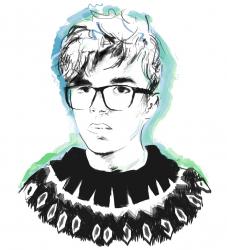As one of the most photographed countries on the planet, it’s easy to communicate what Iceland looks like — even what it feels like. But what does Iceland sound like? For Masaya Ozaki, a composer and audio artist based in Reykjavík, the answer is as complex and captivating as the land beneath his feet.
Masaya is known for his deep explorations of space through sound installations, noise, and contemporary classical music. He has crafted a unique aural experience of this environment with his latest album, Mizukara. Blending ambient and atonal influences with positively geological soundscapes, the album is a richly textured tapestry of local field recordings, electronics, stringed instruments, and more.
Recorded in Iceland over the last year or so, it’s a fitting release for an artist who thrives at the boundaries of genres and mediums; atmospheres and environments; inner and outer worlds.
“Once, my work was all about sound. My sound,” says Masaya. “But now, I think more about the environment. What kind of space? What kind of structures? What about the material?”

Vibration of the space
Born in Niigata, Japan, Masaya’s journey to Iceland began with his passion for music. After feeling like an outsider in his youth, his teenaged discovery of Nirvana opened the door to a musical world. This path led him to Berklee College in Boston and, eventually, New York, where he spent over a decade composing commercial music for TV, films, and adverts.
It was the closure of music venues during the pandemic that sparked a shift in Masaya’s creative thinking. “I realised that physical spaces are vital for music,” he says. “Instead, you had to listen to live sets online. I felt like it wasn’t real. I realised that going to a venue and sharing the moment with other audiences is so important — hearing the vibration of the space is a big part of live music.”
After a series of changes in his personal life (“I had no strings attached to New York anymore”), Masaya moved to Reykjavik for an artist residency. A field recording session in an ice cave profoundly impacted his musical world. “That’s the moment I realised that the sound of water is everywhere,” he says. “It’s usually kind of mundane and everyday — the sound of the shower, or rain dripping from the gutter. But when I noticed the sound of the water dripping in that cave, it was very beautiful because of the space and the acoustics. The realisation that space is essential for sound and music prompted me to really change my composition style.”
Gardening in lighthouses
This shift is evident when you compare Masaya’s 2017 studio album Mythologies with the more recent Echoes for Grótta Lighthouse, which was composed and recorded entirely on location. In a format reminiscent of Ragnar Kjartansson’s The Visitors, five musicians occupied different floors of the Grótta lighthouse, creating an improvised interplay of sound throughout the space. It was an immersive encounter that explored the acoustic peculiarities of a unique building.
Masaya’s digital recordings provide a distinctly more curated experience — a carefully crafted window into a controlled space as it was on that day; a single piece of media which flattens all of that physical acoustic resonance into elegant, densely textured audio.
“It’s important to understand the difference between an MP3 and a live performance, and the possibilities of where this can lead,” says Masaya. “When I’m composing, I often think about Japanese gardeners. Japanese gardening is very different from Western-style gardening. In Japan, gardeners don’t bring materials into the garden — they just rearrange the rocks or cut the bushes, and make a composition out of it.”

Vertical shifts
This approach is partly why Masaya decided to focus on collaborating with Icelandic artists in Mizukara. “These artists were my rocks,” he laughs. “What is so special about being in Iceland is not just the nature, but the community of musicians. For me, it is very, very unique compared to other cities or countries. In New York, musicians work in separate scenes. They rarely seem to cross over, which I feel is very sad. But here, they connect across genres. People here are very humble, very genuine, and very supportive of one another.”
This flirting between scenes and genres mirrors Masaya’s approach to music, which flits between composition, noise, ambient, and sound art. “I’m keen to connect with different crowds and make music on the borderline,” he says. “I want to explore the in-between. That’s why the weather here is important to me. It’s true what they say about Iceland — you can experience every type of weather in one day. It happens very vertically: rain, then wind, then snow, then sun. It’s rarely crossfaded. One thing I focus on in my latest album is this sense of vertical shifts. I trust nature, and I feel that if nature can behave in this way, I can too through my music.”
Check out Masaya’s latest work and upcoming live performances at masayaozaki.com
Buy subscriptions, t-shirts and more from our shop right here!
















